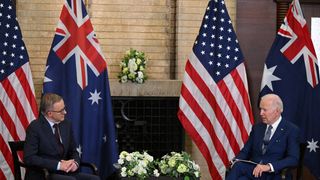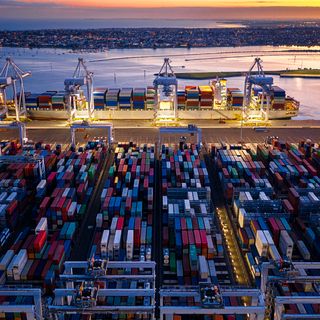Next week, Prime Minister Albanese will travel to the United States for an official state visit hosted by President Biden. The visit is Albanese’s first to the US capital as Prime Minister; the last official visit by an Australian Prime Minister took place roughly two years ago, in September 2021.
As set out by both leaders earlier this year, a modernised Australia-US alliance has three cooperation pillars: defence, economics, and climate and clean energy. While defence cooperation, including AUKUS, attracts the most headlines, the alliance’s second and third pillars on economic cooperation and the clean energy transition are growing in relevance and impact.
In fact, both nations are seeking to increase their cooperation in an area that overlaps all three pillars of the alliance – economic security.
In fact, both nations are seeking to increase their cooperation in an area that overlaps all three pillars of the alliance – economic security. Economic security relates to the use of economic tools of statecraft to achieve strategic outcomes and, over the last year in particular, the United States has ramped up its employment of these tools to counter China.
Two examples are President Biden’s Inflation Reduction Act (IRA) and the CHIPS and Science Act. These pieces of legislation incentivise US domestic manufacturing of clean energy technology and semiconductors, respectively, and also boost efforts to reduce US reliance on Taiwanese chipmakers and critical supply chains involving China. Through these policies, the United States has also significantly limited China’s access to US advanced semiconductors and technologies. Further afield, the United States has sought to engage the region through the Indo-Pacific Economic Framework (IPEF), while also greatly increasing aid to Pacific Islands countries — including the pledging of US$7.2 billion over 20 years to its Compact of Free Association (COFA) partners.
But what do these developments mean for Australia and how should Prime Minister Albanese discuss economic security issues in his meeting with President Biden?
Prime Minister Albanese would do well to raise three key areas: firstly, how Australia can plug into IRA benefits; secondly, how US economic engagement in the region – namely the Indo-Pacific Economic Framework (IPEF) – can be strengthened; and thirdly, how Australia and the United States can coordinate their investments in the Pacific Islands.
Responding to US industrial policy
Key outcome: Australia needs to accentuate the positive and eliminate the negative of the IRA
The IRA is a huge A$613 billion investment that provides loans, grants, subsidies and tax credits for clean energy production and emissions reduction. Many of these investments are also designed to incentivise growth in US domestic manufacturing. For example, the IRA provides tax credits for domestically-produced solar panel components (such as PV wafers, inverters and silicon) by subsidising the manufacturing (e.g., a tax credit of US$12 per square metre for a PV wafer) and purchasing (e.g., a 10 per cent addition to the Investment Tax Credit if solar power components were domestically produced).
These US domestic incentives have received pushback from many countries, including allies like Australia, who worry the incentives will distort the global market and draw capital and talent towards the United States. Australia may benefit from one tax credit, the Clean Vehicle Credit, which subsidises the purchase of electric vehicles that contain critical minerals mined and processed in a country with an FTA (such as Australia), but the vast majority of the IRA’s incentives are for manufacturing in the United States.
Australia has a much capacity to incentivise the domestic manufacture of clean energy technology. This leaves Australia, which also has ambitions to harness the energy transition to develop its domestic industries, vulnerable to global trade distortions. The Australian Government is still in the process of forming a response to the IRA. The Prime Minister’s state visit would be a good opportunity for him to emphasise his Government’s support for Australia’s clean energy transition and industry, and discuss how Australia and the United States can cooperate to benefit both of their economies.
To tackle this challenge, in May 2023, Albanese and Biden announced the Climate, Critical Minerals and Clean Energy Transformation Compact. The Compact included commitments to:
Coordinate the development of clean energy industrial bases in both countries and in the Indo-Pacific region, including critical minerals mining and processing, and clean hydrogen industries
The Australian Government wants to grow its mining industry through investments in the mining and processing of minerals necessary for the clean energy transition, including lithium, rare earths, cobalt and more. Meanwhile, President Biden is looking to secure supplies of minerals from trusted countries for the burgeoning US electric vehicle industry. Prime Minister Albanese should use his meeting with President Biden to highlight Australia’s critical minerals strengths and ambitions to move further up the value chain into minerals processing and battery manufacturing industries. He could emphasise that the United States and Australia can cooperate, such as co-investments by public banks such as Export Finance Australia and the US Export-Import bank, and facilitating offtake agreements (agreements to purchase a portion of future products) between US buyers and Australian miners.
Prime Minister Albanese should use his meeting with President Biden to highlight Australia’s critical minerals strengths.
Hydrogen is a nascent industry that both the United States and Australia have ambitions to build, seeing it as a future export opportunity. Australia has announced a A$2 billion investment in the industry through its Hydrogen Headstart program, but this is dwarfed by recently passed US legislation that include the IRA, which contains tax credits to subsidise the production of hydrogen, and the bipartian Infrastructure and Jobs Act, which invests A$11 billion in seven Clean Hydrogen Hubs. This has led to fears in Australia that the IRA will attract investment away from Australia and towards the United States. While there will inevitably be competition between the countries, Australia and the United States could cooperate on demand-side stimulus, such as coordinating offtake agreements, demand-side action plans (a similar arrangement Australia has with Germany), and co-funding R&D projects to improve the efficiency of the technology.
Include Australia as a domestic source for critical minerals in the US Defense Production Act (DPA)
In March 2022, before the IRA was passed, President Biden authorised the use of the Defense Production Act – which enables the US Government to make direct investments in their industrial base for national security purposes – to invest up to A$783 million in domestic critical minerals. For example, Australian rare earths miner Lynas, has received A$404 million from the US government to construct a rare earths refinery in Texas, with minerals sourced from Australia. In May 2023, President Biden announced his intention to include Australia as a “domestic source” of minerals though legislation that would allow this has yet to be passed. Inclusion as a domestic source could see similar investments to Lynas made on Australian soil. So far, only the US senate’s version of the 2024 National Defense Authorization Act, which remains in the midst of negotiations delayed by the lack of a US Speaker of the House, designated Australia as a domestic source. Prime Minister Albanese should encourage his US counterpart to advocate for this provision to be included in the legislation that eventually becomes law.
Negotiating the Indo-Pacific Economic Framework
Key outcome: Australia should encourage the US to create a roadmap for greater US market access for IPEF members
Since President Trump’s withdrawal from the Trans-Pacific Partnership in 2017, Australia has been hoping for greater US economic leadership in the Indo-Pacific region. Current US initiatives in the region include the Indo-Pacific Economic Framework (IPEF) and increased investments in regional infrastructure and energy. Albanese should use this meeting to emphasise the need for continued US-led economic engagement with the region.
IPEF is the United States’ main economic initiative in the Indo-Pacific, with 14 member countries. As opposed to a traditional free trade agreement, IPEF offers incentives and opportunities across four pillars: trade, supply chains, clean economy, and corruption and tax. However, many of these developing countries lack the capacity to invest significant amounts in implementing best practice, upskilling workers and improving infrastructure under the agreement. Developed members, including Australia and the United States, should play a role here in building expertise.
So far, Australia has committed US$22 million to assist in IPEF capacity building, with the US pitching in US$50 million. In addition, Australia and South Korea announced a joint initiative on monitoring supply chain vulnerabilities. The United States has also announced an IPEF Upskilling Initiative to train women to use digital tools, an IPEF STEM Exchange Program, IPEF trade missions, and training on cargo risk assessment and supply chain monitoring.
Much of the incentive for developing countries to participate in IPEF is the possibility of greater US market access. IPEF is a non-traditional trade agreement that focuses on capacity-building, higher standards and easier trade facilitation rather than removing traditional trade barriers. However, it is unclear how IPEF will create economic opportunities in the region and catalyse investment.
Australia should encourage the US to create a roadmap for developing countries, showing them the pathway for greater access into the US market. This roadmap could include key milestones in the country’s standards, procedures and enforcement that link to how this will catalyse foreign investment and US market access. A greater awareness of how IPEF will enable more economic opportunities for the region would lead to more buy-in on the labour, environmental and anti-corruption standards the United States seeks, retain members in the agreement and ensure that it remains relevant to the region.
Coordinating investment in the Pacific
Key outcome: Reiterate Australia’s increased economic engagement with the Pacific Islands and highlight the benefits to coordinating approaches
The United States and Australia have been concerned with the potential for a Chinese military base in the Pacific Islands for some years but particularly since the leaking of a China-Solomon Islands military agreement in May 2022. Since then, both the United States and Australia have significantly stepped up their economic engagement with the region.
Australia has a long history of investing in the Pacific, but in the last 18 months, Australia has increased its development assistance to A$1.9 billion over five years, doubled its available funding for the Australian Infrastructure Financing Facility for the Pacific, and launched a Pacific-Australia Labour Mobility scheme (which allows Pacific Islanders to work in select Australian businesses for up to 4 years). In 2022, the United States announced an additional A$1.3 billion in development aid to the Pacific and, in September 2023, promised an additional A$315 million, committing to provide A$11.4 billion over 20 years. The challenge for the United States will be getting these financial commitments through Congress and demonstrating US reliability as an economic partner for the Pacific.
The challenge for the United States will be getting these financial commitments through Congress and demonstrating US reliability as an economic partner for the Pacific.
Australia and the United States are seeking to differentiate their approaches from China’s by emphasising quality and resilience to climate change. Their efforts include working trilaterally with Japan through the Blue Dot Network, and multilaterally through the Partners in the Blue Pacific and the Quad. For example, the Quad has announced coordinated investments in undersea cables through the Quad Partnership for Cable Connectivity and Resilience and an Open Radio Access Network (telecommunications capabilities) in Palau. At AUSMIN 2023, the two countries committed to supporting the Pacific Resilience Facility, a Pacific-led fund to provide financing for climate resilience and disaster preparedness.
While increased investment in the Pacific is welcome, the United States and Australia should ensure their engagement maximises the benefits to the Pacific Islands. Coordination of investments in the Pacific is important as these countries are generally small, with governments that can easily become overwhelmed by the increased interest in the region. Only one country (Papua New Guinea) has a population exceeding 10 million. Coordination could entail making joint investments in the same project with one administering organisation, sharing information on the country’s needs and conducting joint technical assistance missions. Prime Minister Albanese should reiterate the importance of economic engagement with the Pacific but emphasise the benefits of coordination to boost their collective impact without overwhelming the region.







